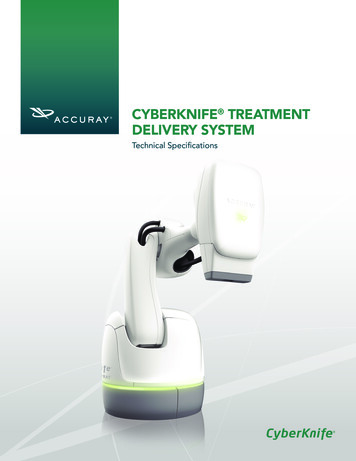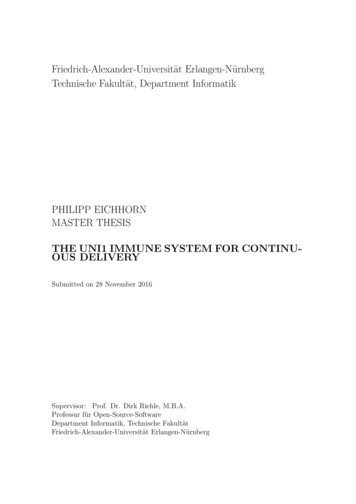
Transcription
CYBERKNIFE TREATMENTDELIVERY SYSTEMTechnical Specifications
The CyberKnife Treatment Delivery System offers a comprehensivetoolkit of clinical features. Indication-specific tumor tracking withautomatic correction throughout treatment; true robotic mobilityand advanced secondary collimation integrate seamlessly into theonly system to stay on target despite patient and tumor movement.Accurately treat tumors throughout the body with confidence andwithout compromise.Key Features and Benefits: Every treatment is delivered in an industry exclusive 3D workspace featuring the flexibility to treat patients with robotic precisionutilizing scores of beam angles in non-coplanar, isocentric or non-isocentric environments. This flexibility and precision instill greatconfidence in clinicians who treat patients with CyberKnife Treatment Delivery System technology. Fully integrated, indication-specific tracking applications precisely monitor patient motion, as well as static tumors and tumorsin motion. Constant intra-fraction position tracking and correction provide confidence that the target is being treated to theprescribed dose. The industry-leading targeting and delivery technology can help to improve patient outcomes. Clinical studies have indicated that the CyberKnife Treatment Delivery System’s unrivaled ability to precisely target and treat diseasehelps clinicians destroy the tumors and not healthy tissue or organs at risk, thus potentially reducing patient side effects. The CyberKnife Treatment Delivery System provides more flexibility than ever with the InCise2 Multileaf Collimator (MLC): fastertreatment times, improved patient handling processes, streamlined setup and treatment, and an optimized linear acceleratorworkspace, to help improve clinician and patient experience.Treatment System OverviewRobotic ManipulatorXchange RoboticCollimator ChangerX-Ray Sources(Ceiling Mounted)Patient PositioningSupport SystemImage Detectors(In-floor Mounted)Treatment Room02Treatment Delivery System Technical Specifications
InstallationTreatment Vault EnvironmentTemperature:10-35 CPressure:103 kPa to 65 kPaHumidity:30% to 75% RH (non-condensing)Mechanical FeaturesRobotic Manipulator 6-axis robotic manipulator mountedon a pedestal at the head of patient area SmartPAD Teach Pendant with atouch screen interface2003 mm [79 in]2144 mm [84 in]830 mm [33 in]R O B O T I C M A N I P U L AT O RS P E C I F I C AT I O N SPayload300 kg (661 lb)Maximum Reach2500 mm (98 in)Number of Axes6Work Envelope41 m3Weight1220 kg (2690 lb)Treatment Delivery System Technical Specifications03
Patient Positioning SupportTwo types of patient positioning support systems are available with the CyberKnife Treatment Delivery System: The RoboCouch Patient Positioning System (optional) or the Standard Treatment Couch.Standard Treatment CouchRoboCouch System (Optional)Payload159 kg (350 lb)Range of Motion Anterior/Posterior Right/Left Superior/Inferior Head Up/Head Down (pitch) Right/Left Tilt (roll) Yaw (CW/CCW)28 cm 15 cm 91 cm 5 5 N/A227 kg (500 lb)42 cm (full vertical range) 18 cm 100 cm 5 5 5 ControlRemote Workstation (UCC)Local Hand PendantRemote Workstation (UCC)Local Hand PendantLocal SmartPAD Teach PendantRepeatability Translational Rotational0.3 mm0.3 0.1 mm0.1 Motion CorrectionsMost degrees of freedom arecorrected seriallyAll degrees of freedom are correctedsimultaneouslyPoint of RotationFixed: Determined by mechanicalassembly of the actuatorsVariable: All axes can move simultaneouslyabout a set point in spaceTreatment Couch Top SpecificationsRadiolucencyMaximum: 1.1 mm aluminum equivalence at 120 kVp for the lengthof at least 62 inches from the superior most pointImmobilizationAlpha Cradle (Compatibility)Vacuum Lock BagsThermoplastic masksIndexingCompatible with CIVCO indexing systemsFlat with StandardFlat with RoboCouch SystemMinimum Load Height 64 cm (25 in) 56 cm (22 in)DimensionsLength: 213 cm (84 in)Width: 53 cm (21 in)Thickness: 7.6 cm (3 in)Length: 206 cm (81 in)Width: 53 cm (21 in)Thickness: 5.7 cm (2.25 in)04Treatment Delivery System Technical Specifications
RoboCouch Robotic Patient Positioning System (OPTIONAL)The RoboCouch System provides a highly flexible six degrees-of-freedom (DOF) mechanism for automatically positioning thepatient. The combination of the RoboCouch System and the robotic manipulator for linac positioning enables the CyberKnife Treatment Delivery System to deliver dose precisely and to the right location automatically. The upper manipulator arm (betweenaxes A2 and A3) integrates a contact sensor on its outer surface and an E-STOP is triggered if an object comes in contact with it.The RoboCouch System is available with a flat carbon fiber couch top (standard with the RoboCouch System). The RoboCouchSystem has five rotational axes and one linear axis.A1A2A6A3A5A4Standard Treatment CouchThe Standard Treatment Couch is the standard patient support system of the CyberKnife System. It provides the user with flexibilityin patient positioning by providing 5 DOF motion capabilities.Treatment Delivery System Technical Specifications05
3D WorkspaceThe robotic manipulator moves within a 3D workspace. This workspace is subdivided into anatomy-specific paths through whichthe robotic manipulator can travel safely from one treatment position to another, accounting for the positions of objects in thetreatment suite, including the treatment couch, patient, imaging components and detectors. The workspace is comprised ofpre-assigned point-in-space, called nodes, from which the manipulator can deliver radiation. The linac can deliver radiation frommultiple beam angles at each node position. The conceptual representations below illustrate the 3D workspace. The actualtreatment path chosen by the robotic manipulator depends on many factors, including the location of the target, the size of thepatient and the anatomy being treated.WorkspacePatient PlaneWorkspace Geometry06Treatment Delivery System Technical Specifications
Linear Accelerator Nominal Source to Axis Distance (SAD) and Normal Treatment Distance (NTD) is 800 mmElectron GunWaveguide4 Port Circulator9.3GHz X-BandMagnetronLinear AcceleratorSimplified Diagram, 6MV Linear Accelerator(shown with InCise2 Multileaf Collimator)Treatment Delivery System Technical Specifications07
Dosimetry Specification Chamber typeDose Chamber A: Sealed ion chamberDose Chamber B: Sealed ion chamber segmented forsymmetry monitoring Resolution 25 counts per MUPHOTON BEAM SPECIFICATIONDosimetry SystemA two-channel primary/secondary dosimetry system is providedX-ray Energy6MV nominal photon energyDepth of Maximum Dose (Dmax)15 mm 2 mmDose Rate1000 MU/min 10% measured at 800 mm SAD at a depthof 15 mm in water for a 60 mm field sizeTemperature and Pressure AdjustmentsWithin the specified operating temperature and pressure range,the dose rate and MU to dose calibration is independent oftemperature and pressureDosimetry LinearityDosimetry linearity with total dose is less than 1% or 1 cGy,whichever is greater over an accumulated range of 10 cGyto 1000 cGy, measured at 800 mm SAD within the operatingtemperature and pressure rangeQuality IndexTPR 20/10 ratio of dose rate in watertank at 20 to 10 cm depthBetween 0.62 and 0.67 for a 60 mm fixed collimatorLeakageMeasured anywhere in the patient plane(800 mm SAD) in a circular area of radius 2 mcentered on the beam’s central axis, excludingthe area within the treatment beam(as defined by IEC 60601-2-1)Leakage in the patient plane is less than 0.2% maximum and0.1% averageScatter 1 m from the radiation head is less than 0.1%The leakage values are given with respect tothe absorbed dose on the central axis at thereference treatment distance of 800 mm SADand 15 mm depth with the 60 mm fixed collimator08Treatment Delivery System Technical Specifications
Equipment RoomEQUIPMENT ROOM COMPONENTSPDU (Power Distribution Unit)Robot ControllersMechanical Rack, including:AMM (Advanced Magnetron Modulator)Rack, including:Computer Rack, including:ChillerAir compressorSF6LCC (Linac Control Computer)LPDU (Linac Power Distribution Unit)MCC (Modulator Control Chassis)Gun driverModulatorModulator HVPSKVM extenderUPSIris temperature controllerMonitor and keyboardELCC (E-Stop Interlock Control Chassis)TLS (Target Locating System) workstationUCC (User Control Console) workstationSFB (Secondary Feedback) workstationiDMS Data Management SystemStorage Vault (option)Network delivery switchNetwork delivery firewallCore switchGateway workstationUCC (User Control Console) WorkstationThe UCC Workstation is installed in the Equipment Room. The workstation includes mouse, keyboard and display at the ControlConsole area. Power is provided to the UCC Workstation through the cabinet UPS.UCC WORKSTATION SPECIFICATIONCPUDual Six-Core CPUsMemory32GB DDR4 2133MHzStorage2x 300 GB SAS 2.0 15 K Drives mirrored for a total of300 GB of storageGraphics CardNvidia Quadro M2000Ethernet Port2x Gigabit ethernet portPower SupplyDual redundant power supplyTreatment Delivery System Technical Specifications09
iDMS Data Management SystemThe iDMS System houses patient records, system commissioning data, and system licensing information and may be housed in theCyberKnife Treatment Delivery System equipment room, or elsewhere, depending on single/multi-system configuration. The iDMSSystem, configured without the Storage Vault option, is intended to store at least 300 patient records. With the Storage Vault option,the iDMS System is intended to store at least 5,400 patient records (depending on plan size, these numbers may change).DATA SERVER SPECIFICATIONCPUQuantity: 4, Dual Intel Xeon E5-2620 v3Memory (RAM)32GB DDR4 2133 MHzC Drive Storage2x2TB drives configured in a RAID 1 providing 2TB storage.Operating system hostD Drive Storage:4x600GB SAS 15k drives configured in a RAID 6 providing 1TB storage. Live patient database and configurationparameters hostE Drive Storage4x2TB drives configured in a RAID 6 providing 2TB storage.Database snapshot and archived patient records hostOperating SystemMicrosoft Windows OSDatabaseSQL Server 2014Storage Vault (OPTION)The Storage Vault is one option that can be used for the redundant backup of the iDMS System. It is housed in the equipment room.STORAGE VAULT SPECIFICATIONQuad-Core CPUIntel Xeon 64-Bit Quad Core CPU, 4 ThreadsMemory8GB DDR3Hard Disk Drive ConfigurationSATA II, 10TB/25TB storage capacityRAID ConfigurationRAID 6Network Interface2 x Gigabit ethernet portsUSB Interface4 x USB 2.0 ports, 2 x USB 3.0 ports10Treatment Delivery System Technical Specifications
Accuray Precision Treatment Planning SystemThe Accuray Precision Treatment Planning System offers a common and complete treatment planning solution for theCyberKnife Treatment Delivery System. The Accuray Precision System is a fully featured, powerful planning workstationfeaturing AutoSegmentation (autocontouring of brain, head and neck, and male pelvis regions), multimodality image fusionwith deformable registration and plan comparison/summing plans. Additionally, this planning system offers the PreciseRTX Retreatment Option. The Accuray Precision System utilizes a common, integrated database: The iDMS Data Management System.ACCURAY PRECISION TREATMENT PLANNINGSYSTEM WORKSTATION SPECIFICATIONCPUDual Six-Core CPUsMemory48GB DDR4 2133 MHzStorage2x240GB SATA (RAID1)Ethernet Port1 GigabitPower Supply 1000 WMonitorLCD monitor with a native resolution of 1600x1200 or 1920x1200Operating SystemMicrosoft Windows 7 x64 Bit OSMD Suite – Physician Workstation (OPTION)The MD Suite – Physician Workstation provides remote secure access to patient record data from the CyberKnife TreatmentDelivery System database. The MD Suite workstation is housed in a remote location.MD SUITE WORKSTATION SPECIFICATIONCPUDual Six-Core CPUsMemory24 GB DDR4 2133 MHzStorage2x240 GB SATA (RAID 1)Ethernet Port1 GigabitPower Supply 1000WMonitorLCD monitor with a native resolution of 1600 x 1200or 1920 x 1200Operating SystemMicrosoft Windows x64 Bit OSTreatment Delivery System Technical Specifications11
Treatment Control AreaThe Treatment Control Area contains equipment necessary for operators to monitor and control the CyberKnife TreatmentDelivery System.TREATMENT CONTROL AREA COMPONENTSTreatment Delivery SystemTwo high-resolution 24”, 1920x1200 pixel monitorsKeyboard and mouse for the user control computerOperator PanelMV Beam indicatorKV Image acquisition indicatorRemote/local control indicatorHigh voltage indicatorHigh voltage enable buttonKey switch to enable high voltageEmergency stop buttonAudible tones for KV and MV radiationOperator PanelDual screens showing the Delivery Interface12Treatment Delivery System Technical Specifications
Collimation SystemsSECONDARY COLLIMATIONThe CyberKnife Treatment Delivery System features three secondary collimator housing types: fixed, Iris Variable Aperture andthe InCise2 Multileaf Collimator. Collimator housing types are automatically changed by the robotic manipulator at the Xchange table. Clinicians can choose the best collimator for the given treatment during the planning process.FIXED COLLIMATORSThere are 12 fixed secondary collimators with circular field sizes ranging from 5 mm to 60 mm in diameter at 800 mm SAD. Thesecollimators can be changed manually to vary the beam size required by the treatment plan.FIXED COLLIMATOR SPECIFICATIONCollimator TransmissionX-ray transmission through the blank collimator at 800 mm SADdoes not exceed 0.2% of the central axis (CAX) dose rate of a60 mm fixed collimatorAvailable AperturesCollimation sizes: 5, 7.5, 10, 12.5, 15, 20, 25, 30, 35, 40, 50and 60 mm nominal field sizes at 800 mm SADPenumbra (At 800mm SAD and 50mmDepth per IEC 60976 (2007) 9.3.1)Better than 3.5 mm for a 10 mm collimatorBetter than 4.5 mm for a 40 mm collimatorBetter than 8 mm for a 60 mm collimatorTable holding Fixed CollimatorsTreatment Delivery System Technical Specifications13
IRIS VARIABLE APERTURE COLLIMATOR (OPTION)The Iris Variable Aperture Collimator creates beams with characteristics virtually identical to those of the fixed collimators and isonly able to replicate the fixed 12 collimator sizes. The variable aperture is created by two banks of six tungsten segments, eachcreating a hexagonal aperture. The two banks are offset by 30 , resulting in a dodecahedral aperture (virtually circular) whenviewed through the collimator.DriveMotorUpper TungstenSegment Bank257.5 mm SAD23.6 mmLower TungstenSegment Bank337.4 mm SAD23.6 mm800 mm SAD NTDIris Variable Aperture Collimator (NTD not to scale)Example of Iris Variable Aperture sizesIRIS VARIABLE APERTURE COLLIMATORSPECIFICATIONThe standard deviation of the radial distance from the beamaxis to the 50% dose level is less than 2% of the averageradial distanceCircularityX-ray transmission through the Iris Collimator tungsten segmentsat 800 mm SAD does not exceed 0.2% of the CAX dose rate ofthe Iris Collimator when opened to a 60 mm field Maximum: 0.2% of the delivered dose rate Average: 0.1% of the delivered dose rateCollimator TransmissionReproducibilityMechanical: less than 0.1 mmTreatment Field Size: 0.2 mm at 800 mm SADdistance of 800 mm SADAvailable AperturesEffective collimation sizes: 5, 7.5, 10, 12.5, 15, 20, 25, 30, 35,40, 50 and 60 mm diameter field sizes at 800 mm SADPenumbra (At 800mm SAD and 50mmDepth per IEC 60976 (2007) 9.3.1)Better than 3.5 mm for a 10 mm collimatorBetter than 4.5 mm for a 40 mm collimatorBetter than 8 mm for a 60 mm collimator14Treatment Delivery System Technical Specifications
InCise 2 MULTILEAF COLLIMATOR (OPTION)The InCise 2 Multileaf Collimator creates highly conformalbeam shapes in relation to the treatment targets and has alarger field size than the Iris or fixed collimators, enablingthe system to treat much larger targets with significantlyfewer beams and delivered MU. This results in much fastertreatment times and greatly expands the clinical utility ofthe CyberKnife Treatment Delivery System.SecondaryFeedbackCameraGuide Block310 mm SADSide ProtectionMount90 mmSide ProtectionPlate425 mm SADPatient’s eye view of InCise 2 Multileaf Collimator800 mm SAD NTDBasic beam line for InCise 2 Multileaf Collimator (NTD not to scale)InCise 2 MULTILEAF COLLIMATORSPECIFICATIONBeam TargetingNon-Coplanar beam targetingSecondary Check for Leaf PositionInternal optical camera provides live images used duringtreatment to verify leaf positionMaximum Geometric Field Size115 mm (leaf motion direction) x 100 mm*Leaf TiltLeaves tilted 0.5 Leaf Tip DesignThree-SidedLeaf Width3.85 mm at 800 mm SAD (normalized for leaf pitch)Leaf MaterialTungstenLeaf Positioning AccuracyBetter than 0.95 mm at 800 mm SAD from either directionat all possible orientationsLeaf Over-Travel100%Leaf Inter-DigitationFull Leaf Inter-DigitationTransmissionIncludes intra-leaf and inter-leaf 0.3% average ( 0.5% maximum) relative to a 100 mm x 100 mmfield size at 800 mm SADPenumbra (At 800mm SAD and 50mmDepth per IEC 60976 (2007) 9.3.1)Better than 3.5 mm in X and Y for 10 mm x 10 mm field sizeBetter than 12 mm in X and 20 mm in Y for a 100 mm x 100 mm field size* Configured by softwareTreatment Delivery System Technical Specifications15
Xchange Robotic Collimator ChangerThe Xchange Robotic Collimator Changer gives treatment operators the ability to automatically change the collimator housingtype (Fixed, Iris , MLC), specific to the patient treatment plan.Side view of Xchange TableTop view of Xchange TableImaging SystemThe CyberKnife Treatment Delivery System uses kV X-ray imaging to pinpoint and track the target throughout treatment. Theimaging system consists of two ceiling-mounted X-ray sources and two corresponding in-floor image detectors. The X-ray sourcesare positioned at 45 such that the generated beams intersect orthogonally at an imaging center located 92 cm above the floor.Treatments on the CyberKnife Treatment Delivery System are based on the patient positioning table accurately bringing thepatient to the imaging field of view. Live X-ray images are then digitized and compared with images synthesized from the patient’streatment plan. Prior to treatment starting, this imaging technology enables the system to automatically adjust the patientpositioning table as target motion is detected. During treatment, the image system automatically adjusts the robot position toensure constant beam accuracy throughout treatment.Imaging System Geometry16Treatment Delivery System Technical Specifications
COMPACT X-RAY GENERATORSPECIFICATIONSConstant Potential Power Rating50.0 kWRadiographic Range40-150 kVp (5% 1 kVp)X-RAY SOURCES SPECIFICATIONSElectrical Nominal Tube Voltage40-150 kV Nominal Focal Spot ValueLarge focus: 1.2 mmSmall focus: 0.6 mm Nominal Anode Input PowerLarge focus: 100 kWSmall focus: 40 kWAluminum Filter2.5 mmCollimator TypeFixed ApertureX-RAY DETECTOR SPECIFICATIONSLower Spec LimitDetector TypeAmorphous silicon with cesium iodide scintillatorPixel Pitch400 µmTotal Area40 x 40 cm2MTF @ 0.25 lp/mm80%MTF @ 1 lp/mm33%DQE @ 0.25 lp/mm, 1 μGy56%DQE @ 1 lp/mm, 1 μGy28%System Targeting AccuracySystem targeting accuracy is a function of many contributing attributes including system calibrations, imaging alignmentand efficacy of clinical elements (patient CT acquisition, treatment planning, delivery). System targeting accuracy can beimpacted by errors generated by these attributes and others like dose delivery. Overall, these elements combine to comprisethe clinically relevant LINAC pointing accuracy, also termed the CyberKnife Treatment Delivery System total targeting error(TTE). The CyberKnife Treatment Delivery System TTE for each tracking algorithm and collimator housing is shown to be lessthan 0.95 mm root mean square (RMS) when a planning CT slice spacing of 1.25 mm or less is used.Treatment Delivery System Technical Specifications17
Target TrackingAccurate target tracking and compensating for target motion are an integral part of the CyberKnife Treatment Delivery System andits capabilities. The target is tracked throughout the treatment and delivery is automatically altered to compensate for any motion.CT REQUIREMENTS FOR TARGET TRACKINGMaximum Slices512kVp120mAsScanner maximum (minimum 400)Slice ThicknessContiguous slice (no gaps); 1.25 mm slice thicknessTarget Tracking Method6D SKULL TRACKING SYSTEMThe 6D Skull Tracking System enables direct tracking of the bony anatomy of the skull when treating intracranial lesions. Targettracking and motion compensation are accomplished by using image intensity and brightness differences between the DRRand live images.FIDUCIAL TRACKINGFor extracranial lesions, targets can be tracked in soft tissue through the use of fiducials. General guidelines for fiducials:o Gold seeds or gold sphereo Diameter: 0.7 mm to 1.2 mmo Length: 3 mm to 6 mm A minimum of three fiducials are required for 6D target tracking correction (X, Y, Z, Roll, Pitch and Yaw).XSIGHT SPINE TRACKING SYSTEMThe Xsight Spine Tracking System, with the patient in the supine position, enables the tracking of skeletal structures in the cervical,thoracic, lumbar and sacral regions of the spine without the need for implanted fiducials.XSIGHT SPINE PRONE TRACKING SYSTEM (OPTION)The Xsight Spine Prone Tracking System provides support for treating spine targets with the patient in the prone position. Thetracking mode combines the Xsight Spine Tracking algorithm with the Synchrony Respiratory Tracking System to offer continuousreal-time tracking and compensation for target motion resulting from respiration. In this tracking mode, the patient is first alignedusing the Xsight Spine Tracking workflow, then a Synchrony correlation model is created to compensate for target translationalmotion during delivery.XSIGHT LUNG TRACKING SYSTEM (OPTION)The Xsight Lung Tracking System (also called 2-View Lung Tracking) tracks tumors in the lung without the use of implanted fiducialsby identifying image intensity differences between the lesion and the background. The patient is initially aligned using the XsightSpine Tracking workflow. After the lesion has been identified, a Synchrony correlation model is created to compensate for targettranslational motion during delivery.18Treatment Delivery System Technical Specifications
LUNG OPTIMIZED TREATMENT: 1-VIEW LUNG TRACKING AND 0-VIEW LUNG TRACKING (OPTION)Lung Optimized Treatment includes a simulation application and two tracking modes: 1-View Lung Tracking and 0-View LungTracking. These two tracking methods supplement the fiducial-free capability of Xsight Lung, regardless of the location of thetumor. The simulation application provides a workflow to select the most appropriate tracking mode 1-View Lung Tracking is used when the treatment target is visible and can be tracked in only one X-ray projectiono Provides direct tracking of lung lesions in two dimensionso Uses an ITV in the non-visible third dimension 0-View Lung Tracking is used when the treatment target is not visible in either X-ray projection. The system tracks the bonyanatomy of the vertebral column during treatmento Provides direct tracking of the spine without fiducialso Uses an ITV in all dimensions to compensate for respiratory motion of the tumorMotion TrackingMotion tracking on the CyberKnife Treatment Delivery System uses the Synchrony Respiratory Tracking or the InTempo Adaptive Imaging System. Motion tracking is used in conjunction with an applicable target tracking method.SYNCHRONY RESPIRATORY TRACKING SYSTEM WITH IMAGE BURSTThe Synchrony Respiratory Tracking System continuously synchronizes treatment beam delivery to the motion of a target that ismoving with respiration. The Synchrony System can be used in conjunction with the following target tracking methods: FiducialTracking, Xsight Lung Tracking, Xsight Spine Prone Tracking and 1-View Tracking.The Synchrony System creates a correlation model between the patient’s breathing pattern (monitored in real-time) and theprecise location of the target (from the imaging system) at various points in the respiration cycle. The target location is determinedfrom X-ray imaging, while the breathing pattern is tracked and monitored using external markers (LED-based, fiber optic trackingmarkers with a tracking frequency of 25 Hz) in real-time.The system automatically determines the best correlation model for the treatment which minimizes overall correlation error. Themodel is chosen from linear, curvilnear, and bi-curvilinear (dual-poly) forms. The model is based on the latest 15 sets of X-rayimages and is updated every time a new image is acquired. This update is further enhanced by the Image Burst feature, whichprovides a 3x increase in the imaging data points that are used to update the breathing model during inter-beam, in-treatment,imaging. This equates to a robust breathing model that stays relevant and accurate for the duration of the treatment, ensuringconfidence in the treatment of moving targets.INTEMPO ADAPTIVE IMAGING SYSTEM (OPTION)The InTempo Adaptive Imaging System is a time-based technology used to compensate for non-periodic intra-fraction motion ofthe target. The InTempo System can be used in conjunction with the following target tracking methods: Fiducial Tracking, 6D SkullTracking and Xsight Spine Tracking.Image AgeImage age is the time elapsed since the most recent image acquisition. The system uses the image age parameter to ensurethat no treatment beam is delivered based on an image that is older than that user-specified value.Adaptive ImagingThe user may optionally enable the system to trigger adaptive imaging in the event that the target motion is greater than auser-defined threshold, which automatically reduces the image age to 15 seconds.Treatment Delivery System Technical Specifications19
Safety Features Contact Detectiono Contact detection sensor at the distal end of the secondary collimator housing on the linaco Contact detection sensor on back of robot armo Contact with the sensor causes an Emergency Stop (E-STOP) condition halting all motion of the system Safety Zones: The robot workspace also takes into consideration the position of the patient and is designed to avoid contact withthe patient. This is achieved by creation of a safety zone around the patient and the treatment couch. The safety zone consists oftwo elements: Fixed and Dynamic.o The fixed safety zone is rigidly attached to the imaging center and thereby the part of the patient body being treatedo The dynamic safety zone is designed to encompass the entire patient body and always lies within the fixed safety zoneo The size of the dynamic safety zone is user selectable based on individual patient sizes (small, medium or large)20Treatment Delivery System Technical Specifications
NetworkSystem Interfaces DICOM Import/Export included:o DICOM Image Importo DICOM RT Structure Set Importo DICOM Image Exporto DICOM RT Structure Set Exporto DICOM RT Dose Export OIS License Required to generate objects:o DICOM RT Plan ExportOIS Requirements*ARIA Oncology Information SystemMOSAIQ Oncology Information SystemRequirements for OIS interfaceCyberKnife System: CK version 9.6 or higherCyberKnife System: CK version 9.6 or higherOIS SoftwareARIA version 10.0 - 11.0MOSAIQ version 2.3 - 2.6NetworkRTPLAN export: TCP port 57347RTRECORD export: TCP port 57345WorkList Server: TCP port 50505RTPLAN export: TCP port 104RTRECORD export: TCP port 10401WorkList Server: TCP port 10401LicenseiDMS License with OIS enablediDMS License with OIS enabledARIA License enabling interface with CyberKnife System MOSAIQ License enabling interface with CyberKnife System * OIS requirements shown are a generic example of how network may be setup; actual configuration site-to-site may change.CyberKnife System LANTreatment RoomEquipment RoomComputer RackMechanical RackTreatment Planning RoomPower Distribution UnitX-ray Source Aand B GeneratorsKUKA Robot Controller Robotic manipulator containing LINACw/attached secondary collimator Xchange Robotic Collimator Changer Imaging subsystem (including X-raysources and detectors) Patient CouchAMM Rack(AdvancedMagnetron andModulator)KUKA RoboCouch Robot Controller(if purchased)Hospital LANOperatorPanelAccuray PlanTouch (option)Accuray TxView (option)PACSHISOperator StationOutside Hospital LAN(remote access)OIS Server(MOSAIC/ARIA)Imaging ModalitiesCT, MRIAccuray Precision Treatment Planning System/MD Suite(can be inside or outside of CK LAN)Accuray PrecisionTreatment Planning System/MD Suite(can be inside or outside of CK LAN)Remote Accuray ServiceConnection (option)Network DiagramTreatment Delivery System Technical Specifications21
M6 Base System ConfigurationsConfigurationsFeatureM6 FIMM6 FI M6 FMM6 FIImage Guidance System Robotic Manipulator Treatment Delivery Control Console 1000 MU/min linac Fixed Collimators Iris Variable Aperture Collimator InCise 2 MultiLeaf Collimator Xchange Robotic Collimator Changer Standard Treatment Couch RoboCouch Patient Positioning System Fiducial Tracking System CNS Package Including: 6D Skull Tracking System Xsight Spine Tracking System Brain AutoSegmentation Prostate Package Male Pelvis AutoSegmentation In Tempo Adaptive Imaging System Spine Prone Package Synchrony Respiratory Tracking System Xsight Spine Prone Tracking Lung Package Synchrony Respiratory Tracking System Xsight Lung Tracking System Lung Optimized Treatment Monte Carlo Dose Calculation 4D Treatment Optimizationand Planning System – STANDARD FEATURE2222Treatment DeliveryDelivery SystemSystem TechnicalTechnical SpecificationsSpecificationsTreatment– OPTIONAL FEATURE
System ConfigurationsConfigurationsM6 Base SystemFeatureM6 FIMM6 FI M6 FMM6 FISpine Prone Lung Package Xsight Spine Prone T
Operating System Microsoft Windows OS Database SQL Server 2014 Storage Vault (OPTION) The Storage Vault is one option that can be used for the redundant backup of the iDMS System. It is housed in the equipment room. STORAGE VAULT SPECIFICATION Quad-Core CPU Intel Xeon 64-Bit Quad Core CPU, 4 Threads Memory 8GB DDR3










